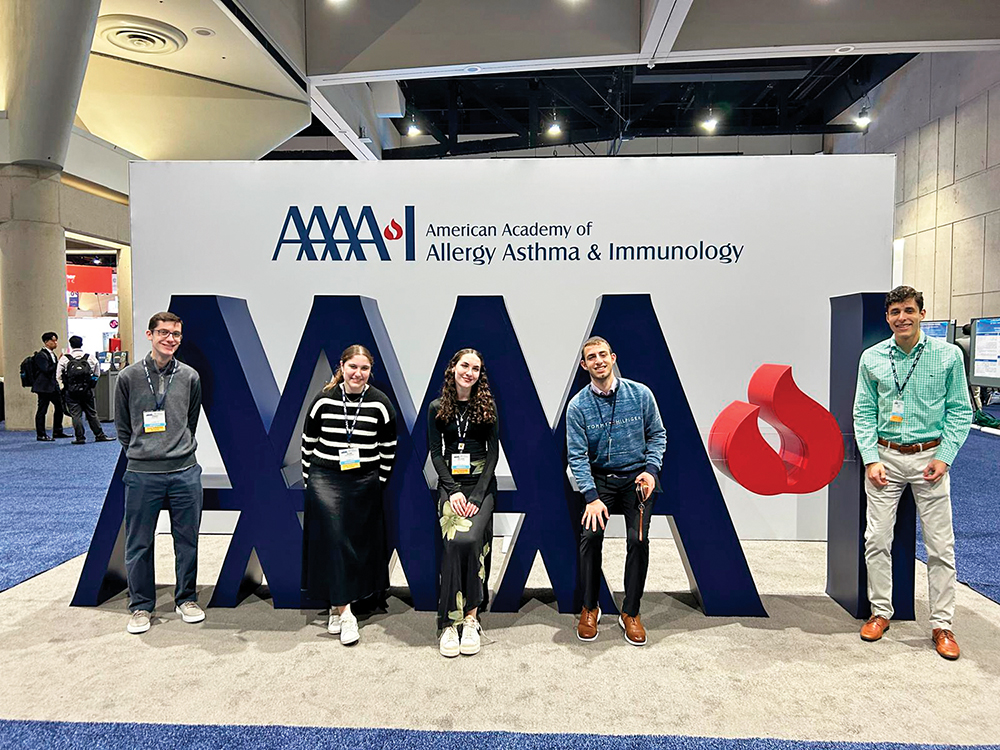
(Courtesy of RKYHS) In a packed conference hall five students from the Rae Kushner Yeshiva High School (RKYHS) stood before some of the world’s leading allergy and immunology experts as the only high school students in attendance. The 2025 American Academy of Allergy, Asthma & Immunology (AAAAI) and World Allergy Organization (WAO) joint meeting in San Diego earlier this month is an international conference of scientists and physicians.
Their groundbreaking research on real-time airborne pollen identification had not only earned them a spot at this prestigious event with two accepted papers, but also saw one of their papers selected as a “featured presentation”—meaning it was recognized among the top 3% out of nearly 1,000 submitted papers. This achievement highlighted the growing national reputation of the RKYHS Scientific Research Training Institute (SRTI) program, which is redefining how young minds engage in science through authentic scientific research.
For allergy sufferers, the ability to predict and track airborne pollen species in real time could mean the difference between comfort, an asthma attack, and an emergency room visit. The students’ research tackled this challenge by developing the first real-time pollen identification system. Their innovative system integrates DNA sequencing and microscopy-based image recognition within an artificial intelligence/ machine-learning framework. This can revolutionize the way allergy forecasts are generated, shifting from broad regional general predictions to hyperlocal, species-specific alerts that could help individuals manage their conditions more effectively.
The RKYHS-SRTI researchers, 12th graders Naomi Rosenbluth, Jonah Klein, Aidan Korish, 11th grader Melanie Huppert, and recent grad Gal Usi (RKYHS ‘24) who performed the research while at RKYHS, presented their unique findings with the same professionalism, confidence, and expertise exhibited by the seasoned scientists in attendance, adeptly fielding complex questions. These young scientists were presumed by many attendees to be early-career researchers—perhaps young physicians, scientists, or medical students. The realization that these presenters were high school students was met with disbelief—quickly followed by admiration.

“In all my years attending these conferences, I’ve never seen anything like this,” said Dr. Leonard Bielory, an internationally recognized allergist/immunologist and renowned pollen expert. “This shows why it’s so important to introduce authentic science research at the high school level. They’re ready and thirsty for it. They’re not just repeating textbook knowledge. They’re contributing real advancements to the field.”
The success of these student scholars was no accident. The SRTI is not a typical high school science program. Instead of relying solely on lectures and conventional classroom experiments, SRTI immerses students in authentic, cutting-edge research. The institute currently trains scores of students across all high school grade levels in a hands-on, inquiry-driven approach that mirrors university and industry research environments.
Under the guidance of expert mentors, SRTI students develop projects, design experiments, analyze data, and present their findings at professional scientific conferences. The SRTI philosophy—“learning science by doing science”—teaches students to think critically, analyze problems, and contribute meaningfully to the scientific community.
SRTI is an ambitious, research-driven program, founded and directed by Dr. Steven Stein, a research virologist, patent attorney, and RKYHS Science Department chair. “I had long been troubled by the firehose of information and memorization approach of science education, which teaches away from the excitement and creativity of really doing science,” said Stein. “When RKYHS presented the opportunity to take a different approach, we ran with it.”
The Institute boasts an impressive suite of advanced laboratory facilities that rival those of many research universities. These include a microscopy lab equipped with a scanning electron microscope (SEM) and phase-contrast fluorescence microscopes, a tissue culture lab with biosafety cabinet laminar flow hoods and CO2 incubators, and a fabrication lab featuring 3D printers, CNC machines, and laser cutters. Additionally, a molecular genetics lab houses thermocyclers, spectrophotometers, and a next generation DNA sequencer, enabling students to conduct high-level genetic analyses.
The breadth and depth of the lab’s capabilities allows students to explore projects in fields such as neurotropic diseases, cancer, biomedical devices, artificial intelligence, and genetics. This rich research environment has positioned SRTI as one of the most advanced high school research programs in the country.
The Sky’s The Limit: Cutting-Edge Research in a High School Setting
SRTI student scholars are no strangers to pushing scientific boundaries. One recent project, conducted in collaboration with NASA, focused on assessing DNA damage and repair mechanisms in preparation for long-duration space travel (such as to the Moon or Mars). This work was presented nationally at the American Society for Gravitational and Space Research (ASGSR) conference. And students are continuing to pursue this model to investigate how different environmental conditions, such as UV radiation and environmental chemicals affect DNA repair pathways in mammalian cells and in cancer.
Another groundbreaking SRTI project involves the development of a custom-designed 3D tissue printer, which has recently been used by students to print 3D “mini” brain organoids out of cancer cells to investigate the mechanisms underlying glioblastoma, a devastating brain cancer. Another SRTI team is working on developing 3D-printed lung organoids to investigate cystic fibrosis and still another team is working to print heart organoids. Other SRTI teams are developing molecular screening systems for infections and others to determine the efficacy of certain chemotherapies.
The Ripple Effect of Student-Led Science
The impact of SRTI extends beyond the students who participate. By involving high school students in rigorous, innovative research, the institute challenges traditional assumptions about how science can be taught as well as when and where meaningful scientific contributions can occur. The program also fosters a culture of mentorship, as older students guide younger ones through the research process, creating a pipeline of scientific inquiry that strengthens each successive cohort. Projects can continue not for a day or week—but for years.
For the five students who presented in San Diego, the experience was transformative. Standing before top-tier scientists and clinicians, they fielded questions, defended their methodologies, and discussed potential implications of their research. The validation of their work at a prestigious international conference reinforced their confidence in their abilities and their belief in the power of student-driven discovery.
“Getting to attend the conference gave me a glimpse into my future as a researcher. It gave me confidence and showed me what I am capable of when I am surrounded by people who believe in me,” said Rosenbluth, one of the student presenters.
The SRTI program continues to attract increasing numbers of students eager to take on ambitious research projects. Requests to join the SRTI program continue to surge—even among students who don’t think of themselves as “STEM-kids,” reflecting a growing recognition that hands-on research experiences provide an unparalleled advantage for students regardless of whether they wind up pursuing careers in science, medicine, and engineering. According to Stein, “The critical thinking and analytic skills they acquire in this program serve the students well no matter what field they ultimately go into.”
A Model for the Future of Science Education
The SRTI is more than just a school program—it is a model for how science education should be approached in the 21st century. By treating students as real researchers and giving them access to professional-grade equipment and mentorship, SRTI has demonstrated that young minds are capable of making significant contributions to the scientific community.
Their recent success at the AAAAI/WAO conference is not just a testament to the students’ intelligence and dedication but also to the effectiveness of a research-driven educational model. As more schools look for ways to inspire the next generation of scientists, the SRTI approach offers a compelling blueprint.
As Klein articulated after the conference, SRTI is “an amazing scientific research program, … engendering a love and passion for curiosity and science within me since ninth grade. It truly was one of the highlights of my high school experience.”
“Our students aren’t just learning about science,” said Stein, “they are doing science and doing it at the highest levels. What they take away from the program, they keep for a lifetime. This is what science education should be, real discovery, real impact—real science.”








